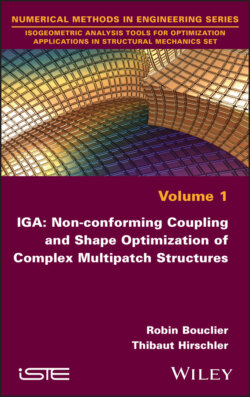Читать книгу IGA - Robin Bouclier - Страница 35
1.5.4. Nitsche coupling
ОглавлениеUnlike Mortar approaches, the coupling is established from a primal formulation in the Nitsche technique. This time, both of the interface Dirichlet and Neumann conditions [1.36] are enforced in a weak sense. More precisely, a connection between the Nitsche and Lagrange multiplier couplings can be made (see, for example, Fritz et al. (2004) and Bazilevs et al. (2012)). Starting with the Lagrange multiplier method, the idea to obtain the Nitsche method is to replace the Lagrange multiplier by the mean interface resultant force coming from the displacement. We therefore define the average of the stresses and of the virtual stresses as follows:
[1.44]
and obtain the following Nitsche bilinear form:
[1.45]
where we again use the jump operator [1.40]. This bilinear form finally needs to be enriched with a stabilization term to ensure the ellipticity of the boundary value problem. Denoting the stabilization parameter by αnit, the stabilized variational formulation of the problem using the Nitsche approach can be written as follows: find (u1, u2) ∈ 1 × 2, such that:
[1.46]
The main advantages of the Nitsche approach in comparison to other coupling techniques are its variational consistency, as well as the positive definiteness, symmetry and good conditioning properties directly obtained for the final coupled stiffness operator. In addition, the absence of auxiliary fields simplifies the theory. While in formulation [1.43], a suitable approximation space for the Lagrange multiplier needs to be chosen, the Nitsche approach [1.46] requires the choice of a suitable value for αnit. It has been shown that good estimations of αnit can be obtained, for example, by solving a generalized eigenvalue problem (Apostolatos et al. 2014b; Nguyen et al. 2014) or several local eigenvalue problems (Ruess et al. 2014; Jiang et al. 2015) over the interface. It is also worth mentioning at this stage that a non-symmetric version of the Nitsche method exists, which has the interest of being weakly stable without adding any stabilization terms (Schillinger et al. 2016a; Guo 2017; Hu et al. 2018). However, as with the penalty approach, the stiffness operators of the different sub-domains are merged together in the Nitsche coupling. This makes, at first glance, the derivation of efficient (parallel) algorithms and the use of different numerical codes for the resolution complicated, compared to Lagrange multiplier schemes. Furthermore, the true implementation of the method in contexts beyond standard solid elasticity may not be straightforward due to the emergence of the mean interface resultant stress [1.44]. For example, the formulation of the stress resultants transfer, for connecting two shells that intersect with an arbitrary angle, seems delicate (see Chapter 3). In the same idea, the definition of the virtual mean interface resultant stress is not obvious in the case of material nonlinearities (e.g. plasticity or damage). In Chapter 2, we will develop a new non-invasive coupling strategy based on the non-symmetric variant of the Nitsche methodology, which will result in a flexible and efficient tool to perform global/local isogeometric simulations.
NOTE.– It may be finally noted that with the Nitsche technique, the average operator in equation [1.44] can be defined more generally. Any convex combination can actually be chosen without violating the consistency of the formulation (Hansbo 2005; Bazilevs et al. 2012). As a result, we can use:
[1.47]
In particular, when there is an important contrast between the two materials to be coupled, it could be interesting to adjust the convex combination to counterbalance the material gap and therefore preclude the emergence of undesirable mesh locking phenomena (Sanders et al. 2012). Such treatment has been performed in the non-invasive algorithm proposed in Chapter 2, to properly introduce a stiff inclusion within a soft B-spline patch (see Bouclier and Passieux (2018)).
